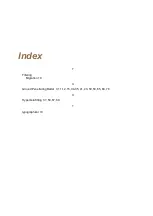
S
signature
A representation of the reflected radar signal in a GPR profile. Reflected signals are
caused by changes in the dielectric properties of the target medium. These dielectric dif-
ferences are usual caused by differences in materials, e.g., a buried object or reinforcing
in concrete. Objects of a discrete length are generally characterized by a hyperbolic
reflection in the GPR profile, and are referred to as point source reflections. A linear
object, such as a pipe, will also display the characteristics of a discrete-length object if
the GPR scan is performed perpendicular to its longitudinal alignment, and are referred
to as planar reflections. As the scan is moved towards the longitudinal alignment of the
linear object, the hyperbolic refection flattens until it approaches a horizontal line in the
GPR profile. The shape of the signature is also affected by many other factors, including
the size of the object, the signal velocity, and the object material.
SSD
SSD is an abbreviation for Solid State Drive, which the a randon access memory device
used to storage data.
Standard GPS
Relatively inexpensive GPS that only uses satellites for positioning, These systems
generally have an accuracy around ± 4 m and are suitable for large scale layer mapping
projects.
T
Time-Gain
Time-Gain applies a time-varying gain to compensate for amplitude loss due to spread-
ing and attenuation. The trace is multiplied by a gain function combining linear and an
exponential gain, with coefficients set by the user.
trace
A "trace" is a single, vertical column of GPR data, representing the signal "traced" by a
radar pulse as it travels from the instrument into the subsurface. Each trace is com-
posed of individual "samples," the smallest measurement unit in the vertical dimension.
Because of geometrical "spreading," the radar signal decreases in strength with depth
as 1/r2, where r is depth.


































